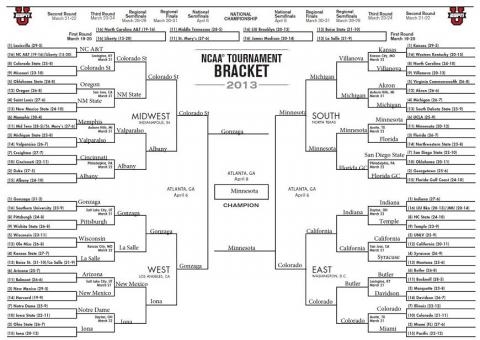With the Sweet Sixteen round of the NCAA men’s basketball tournament under way, we’ve all become experts in bracketology (see President Obama’s picks here). But how would the tournament play out if teams advanced according to their state’s ranking on our model law?
In the Midwest region, we’d see an immediate fall of the number one seed. As one of only eight states that does not allow parents the opportunity to choose a public charter school for their child, Kentucky-based Louisville would quickly be knocked out. Second seed Duke would also be eliminated in the first round—New York-based Albany holds the eighth spot on our model law, while North Carolina is twenty-fourth. Despite its eighth seed in the tournament rankings, Colorado State’s home base holds the fourth strongest public charter school legislation in the nation, which would carry it to win the Midwest region. The West region would advance according to the top tournament seed. Gonzaga is located in Washington, which comes in third on our model law rankings. Unlike in actual tournamet play, this high model law ranking would easily carry the first seed Gonzaga to win the region. On the other side of the bracket, Ohio State University falls in the bottom half of the 42 states with public charter school legislation, and would be upset by Iona’s New York-based ranking as one of the top ten states on our model law. In the East, we’d see strong several strong contenders: Indiana (ranked 9 on our model law) would vie with California (seventh spot on the model law), and Butler (Pennsylvania is 19th on our model law) would duke it out with Colorado (fourth in the model law rankings)—which would go on to win the East region. Finally, the South region would behold the ultimate Cinderella story. Minnesota tops our model law rankings, which would carry the 11 seed to win the entire tournament. While we would not recommend actually filling out your bracket according to this methodology, this theoretical tournament bracket does point out states that are committed to improving the statutes that enable a thriving public charter school sector.







